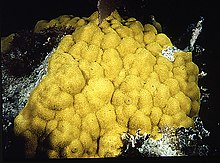
Anthozoa is a class of marine invertebrates which includes the sea anemones, stony corals and soft corals. Adult anthozoans are almost all attached to the seabed, while their larvae can disperse as part of the plankton. The basic unit of the adult is the polyp; this consists of a cylindrical column topped by a disc with a central mouth surrounded by tentacles. Sea anemones are mostly solitary, but the majority of corals are colonial, being formed by the budding of new polyps from an original, founding individual. Colonies are strengthened by calcium carbonate and other materials and take various massive, plate-like, bushy or leafy forms.

Pillar coral is a hard coral found in the western Atlantic Ocean and the Caribbean Sea. It is the only species in the monotypic genus Dendrogyra. It is a digitate coral -that is, it resembles fingers or a cluster of cigars, growing up from the sea floor without any secondary branching. It is large and can grow on both flat and sloping surfaces at depths down to 20 m (65 ft). It is one of the few types of hard coral in which the polyps can commonly be seen feeding during the day.
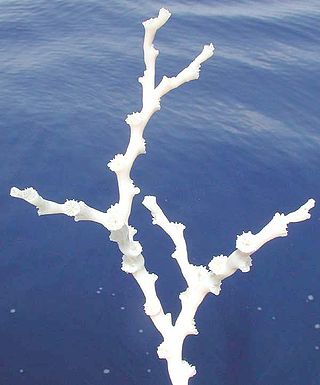
Lophelia pertusa, the only species in the genus Lophelia, is a cold-water coral that grows in the deep waters throughout the North Atlantic ocean, as well as parts of the Caribbean Sea and Alboran Sea. Although L. pertusa reefs are home to a diverse community, the species is extremely slow growing and may be harmed by destructive fishing practices, or oil exploration and extraction.

Porites is a genus of stony coral; they are small polyp stony (SPS) corals. They are characterised by a finger-like morphology. Members of this genus have widely spaced calices, a well-developed wall reticulum and are bilaterally symmetrical. Porites, particularly Porites lutea, often form microatolls. Corals of the genus Porites also often serve as hosts for Christmas tree worms.

Porites lobata, known by the common name lobe coral, is a species of stony coral in the family Poritidae. It is found growing on coral reefs in tropical parts of the Indian and Pacific Oceans.

Millepora alcicornis, or sea ginger, is a species of colonial fire coral with a calcareous skeleton. It is found on shallow water coral reefs in the tropical west Atlantic Ocean. It shows a variety of different morphologies depending on its location. It feeds on plankton and derives part of its energy requirements from microalgae found within its tissues. It is an important member of the reef building community and subject to the same threats as other corals. It can cause painful stings to unwary divers.

Umimayanthus parasiticus, commonly known as the sponge zoanthid, is a species of coral in the order Zoantharia which grows symbiotically on several species of sponge. It is found in shallow waters in the Caribbean Sea and the Gulf of Mexico.

Siderastrea radians, also known as the lesser starlet coral or the shallow-water starlet coral, is a stony coral in the family Siderastreidae. It is found in shallow parts of the western Atlantic Ocean as small, solid mounds or encrusting sheets.

Parazoanthus swiftii, commonly known as the golden zoanthid, is a species of coral in the order Zoantharia which grows symbiotically on several species of sponge. It is found in shallow waters in the Caribbean Sea and western Atlantic Ocean.
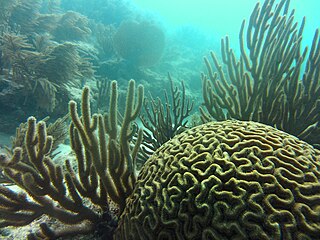
Pseudodiploria strigosa, the symmetrical brain coral, is a colonial species of stony coral in the family Mussidae. It occurs on reefs in shallow water in the West Atlantic Ocean and Caribbean Sea. It grows slowly and lives to a great age.
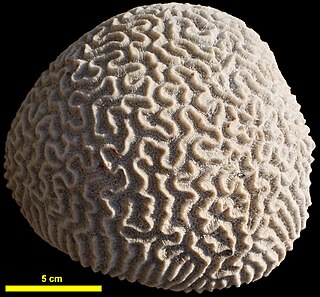
Pseudodiploria clivosa, the knobby brain coral, is a colonial species of stony coral in the family Mussidae. It occurs in shallow water in the West Atlantic Ocean and Caribbean Sea.

Scolymia lacera, the fleshy disk coral, is a species of stony coral in the family Mussidae. It occurs on reefs in shallow waters in the Caribbean Sea, the Gulf of Mexico, the Bahamas, Bermuda and southern Florida.

Porites porites, commonly known as hump coral or finger coral, is a species of stony coral in the genus Porites. It is found in the Caribbean Sea and western Atlantic Ocean and also along the coast of West Africa.

Porites furcata, commonly known as hump coral, thin finger coral or branched finger coral, is a species of stony coral in the genus Porites. It is found in the Caribbean Sea and western Atlantic Ocean.

Dichocoenia is a monotypic genus of stony coral in the family Meandrinidae. It is represented by a single species, Dichocoenia stokesii, which is commonly known as pineapple coral, elliptical star coral, or pancake star coral. It is mostly found in the Caribbean Sea and the western Atlantic Ocean. Dichocoenia stokesii has irregular calyces and its form can be either a massive, hemispherical hump or a flat, platform-like structure.
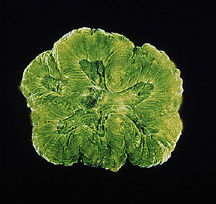
Isophyllia sinuosa, the sinuous cactus coral, is a species of stony coral in the family Mussidae. It is found in shallow water in the tropical western Atlantic and the Caribbean Sea.
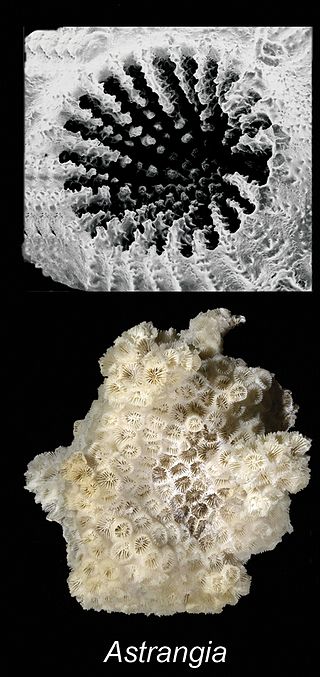
Astrangia poculata, the northern star coral or northern cup coral, is a species of non-reefbuilding stony coral in the family Rhizangiidae. It is native to shallow water in the western Atlantic Ocean and the Caribbean Sea. It is also found on the western coast of Africa. The International Union for Conservation of Nature lists this coral as being of "least concern". Astrangia poculata is an emerging model organism for corals because it harbors a facultative photosymbiosis, is a calcifying coral, and has a large geographic range. Research on this emerging model system is showcased annually by the Astrangia Research Working Group, collaboratively hosted by Roger Williams University, Boston University, and Southern Connecticut State University
Pseudoplexaura porosa, commonly known as the porous sea rod or the porous false plexaura, is a species of gorgonian-type colonial octocoral in the family Plexauridae. It is native to the Caribbean Sea and the Gulf of Mexico.

Porites cylindrica, commonly known as hump coral, is a stony coral belonging to the subclass Hexacorallia in the class Anthozoa. Hexacorallia differ from other subclasses in that they have 6 or fewer axes of symmetry. Members of this class possess colonial polyps which can be reef-building, secreting a calcium carbonate skeleton. They are dominant in both inshore reefs and midshelf reefs.

Manicina areolata, commonly known as rose coral, is a colonial species of stony coral. It occurs in shallow water in the West Atlantic Ocean and Caribbean Sea, sometimes as small solid heads and sometimes as unattached cone-shaped forms.
